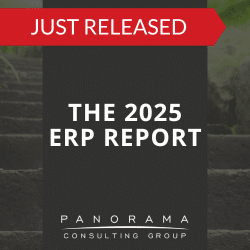When it comes to ERP software, the more informed you are about selection and implementation best practices, the less risk your organization will incur. That’s why we wrote this guide to ERP. We’ll discuss everything from project planning to data management to organizational change management. Buckle in!
ERP Vendor Selection Best Practices
You’ve taken the first step and decided to implement an ERP system at your organization. Now, the real work begins.
The ERP vendor selection phase involves the following activities:
1. Building an ERP Project Team
When you have a dedicated project team, you’re more likely to select an ERP product that fits your company’s needs.
This team should include:
- A project manager
- Department heads
- Senior executives
- IT leaders
2025 Clash of the Titans
SAP, Oracle, Microsoft, and Infor each have a variety of systems that can support data-driven decision-making. We surveyed customers of these four vendors to find out what their selection and implementation process was like.
2. Ensuring Executive Buy-In
It’s important to seek and secure executive buy-in right from the start, as you’ll need their support throughout the project. Building a strong business case and clearly demonstrating the benefits that an ERP system will bring can help you secure executive involvement.
3. Defining ERP Requirements
The project team should define ERP requirements by understanding current and future use cases and asking stakeholders about their pain points. They may also perform business process reengineering to define the desired future state and determine which ERP features are needed.
4. Meeting Vendors and Scheduling Demos
Once you’ve gathered requirements, you’ll have the framework you need to start evaluating vendors and creating a list of top contenders.
Ask each of these “long-listed” vendors to submit a request for proposal (RFP) that details how their solution will meet your requirements. As RFPs come in, you can narrow your list even more to create a “shortlist” of viable options. Ask these vendors to schedule an in-person software demo to show your team how their solution works in a real-world environment.
Finally, it’s time to compare each vendor’s statement of work and make a final decision. During this stage, it can be helpful to hire an independent ERP consultant with software contracgt negotiation experience.
ERP Pre-Implementation Best Practices
During this time, you’ll ensure that your project strategy is clearly defined, and everyone is aligned regarding organizational goals.
Some of the most important steps that occur during this phase include:
1. Defining a Resource Strategy
While your vendor might do the bulk of the design and deployment work, your internal team needs to be heavily involved with various project activities. Thus, you need a resource strategy. This should include a backfill strategy that outlines how you’ll continue to support your mission-critical work.
2. Defining a Data Management Strategy
When you implement an ERP solution, you need to migrate your existing data from your legacy systems into the new ERP platform. However, before you do this, you need to prepare your data.
This is where a data management strategy comes in. In particular, you need a strategy for how you will handle the data conversion and data reconciliation process.
For example, how will you analyze the accuracy, timeliness, and relevancy of your current data? What resources will you need to cleanse the data?
3. Defining a System Infrastructure
When it comes to system infrastructure, you have two primary options: on-premise ERP or cloud-based ERP. Both offer their advantages and drawbacks, and there isn’t a one-size-fits-all answer that will work for everyone.
To determine the best route for your company, take the following into consideration:
- Your unique business requirements
- Your budget
- Your long-term organizational goals
4. Defining Your Organizational Change Management (OCM) Strategy
An organizational change management strategy is essential to the success of any ERP project. This strategy details stakeholder needs and how you plan to communicate with them. It also helps you assess change readiness during the ERP selection phase and helps you identify change resistance throughout the length of the project. Employees who are used to the familiar way of doing things may buck the idea of change, no matter how beneficial the new system might be.
ERP Implementation, Go-Live, and Post-Go-Live
This is a formal process that follows defined project management methodologies. Key components include:
- Software configuration
- Change request management
- System testing
- Data migration
- End-user training
- Continued OCM
Once the system goes live, the project is far from over. Analyze user adoption and compare use metrics against pre-defined key performance indicators. As issues arise (and they likely will), determine what’s working and what needs to be adjusted.
An ERP implementation is ongoing, and your employees will require support even after you reach the veritable “finish line.”
Expanding on This Guide to ERP
An ERP implementation is a multi-phase process that requires a hefty commitment from your internal team members. Before you dive in, take a look at the roadmap provided in this guide to ERP so you can ensure your company is ready to start the journey.
Our ERP consultants can help you with every stage of your project, from ERP selection to post-go-live support. Contact us below for a free consultation.













